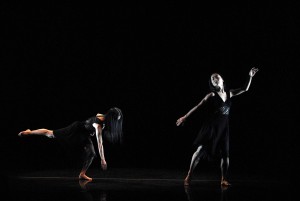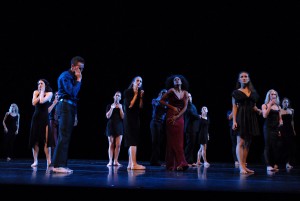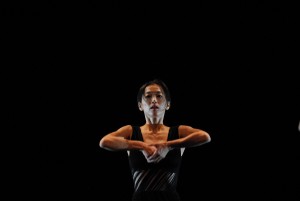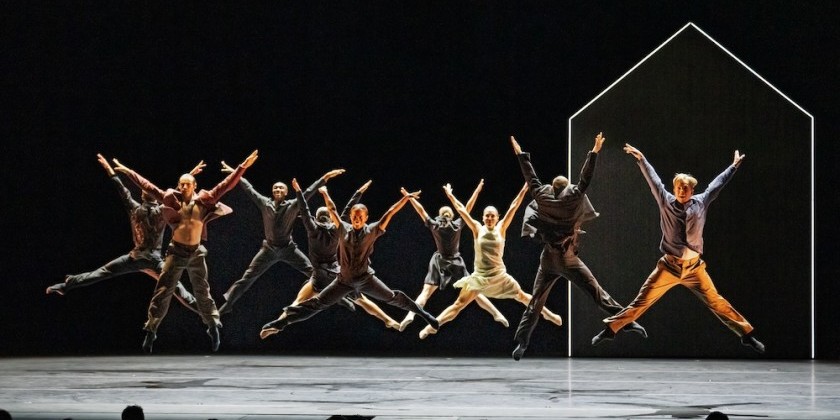Impressions of "LAMENTATION VARIATIONS" Article by Christine Jowers - Photos by Nan Melville

| EXCERPTS FROM A STUDY OF LAMENTATION Courtesy of Martha Graham Resources |
Impressions of “LAMENTATION VARIATIONS”
Featuring Slideshows by Nan Melville 2007
“LAMENTATION VARIATIONS”
Choreography by Aszure Barton, Richard Move, and Larry Keigwin
Music by George Crumb, DJ Savage, and Frederic Chopin
Lighting by Beverly Emmons
Conceived by Janet Eilber
Performed by: The Martha Graham Dance Company
Premiere: September 11, 2007, Joyce Theater New York City
The lights dim. A body fills the backstage screen. It is an early film of Martha Graham performing excerpts from Lamentation- not the actual solo, but elements of it without music. The absence of sound is arresting. Out of the fabric emerges an intelligent beautifully carved face. Awesome cheekbones. Full lips. Notice the sculpture of the hands- the miracle of the body. We do not need to see the full dance to know that Martha Graham was intrigued by miracles and mysteries. Watching this film we are captivated by the phenomenon of her form – Is this woman rising from the fabric or being swallowed up by it? Are we witnessing a birth or a death? This is our collective moment of contemplation - an unannounced moment of silence.
The choreographers Aszure Barton, Richard Move, and Larry Keigwin began creating their material for Lamentation Variations as sketches in reaction to Martha Graham’s Lamentation. The video shown at the beginning of the performance was part of a collection of inspirational material given to them by The Graham Company.
While each choreographer may have begun by working on a sketch, what they offered up this opening night, The Eightieth Anniversary Season of the Martha Graham Company and the sixth anniversary of the tragedy of September 11, were three distinct memorials to the lives of their fellow New Yorkers lost six years ago.
They entreated us to notice the miracle of the body in its simplicity, and to remember what we share with all bodies on this earth besides birth and death - a search for meaning, for peace, and light, mixed with the individual quirky behaviors habits, frustrations and loves that make us human.








|
| Martha Graham Company Photos by Nan Melville - www.nanmelville.com |
Azsure Barton’s contribution was a duet for women (Miki Orihara and Yuko Giannakis), women who, on stage, look so much alike we wonder if we are hallucinating: both are Asian, extremely petite, and dressed in short black cocktail dresses. They dance in sharp angles, breaking in half from the center of the torso like shards of glass. They appear to be two parts of a whole. Perhaps twin towers? The duo peppers their phrases with spasmodic tweaks and jerks of their eyes, mischievous Cheshire cat smiles and, at different times their tongues dart into their cheeks creating an odd asymmetrical face bubble. “Hey look it here,” they appear to say, “ We may have broken in two, but remember that we were edgy, individual, gum-cracking, black –wearing, filled-with-attitude New Yorkers. We are not to be recalled as victims.”
I
n Richard Move's surreal solo, the attention is on Katherine Crockett's torso. Graham's original lament also focuses on this part of the body. But, while Graham erupted in a series of angled, flexed, and stretched actions of grief, Crockett travels in a long smooth arc, falling from an upright stance into a beautiful backbend.


|
| Martha Graham Company Photos by Nan Melville - www.nanmelville.com |
Intellectually we are aware that Ms. Crockett is using her legs to travel from stage right to stage left, but because she is wearing black on a stage engulfed in blackness -save a glowing a tube of light shining from the side- it appears that she is levitating. The music by DJ Savage is eerie, reminiscent of the white fuzzy noise from a radio, and definitely not of our time zone. The sound, Crockett’s body, and the light unite to create a weightless environment hovering beyond our grasp. As she nears the end of this journey into light, her back lifts, her head begins to rise. We think we may see her face, but we never do. This is no longer a human body. We may very well be witnessing a soul escaping to heaven.
Of the many striking images of September 11th 2001, one may recall somber parades of people covered in ash -stunned masses- some with clothes ripped and bloodied, walking uptown away from that horrible smoke. Other images are of people never found. Often only small personal items, such as jewelry, or tiny photographs, or little bits of paper were the only clues left that a body once existed. Larry Keigwin’s dance, the finale of Lamentation Variations, erases those pictures and for a moment in time brings all the lost souls back to us. The people we see are not broken. They are not dead.





|
| Martha Graham Company Photos by Nan Melville - www.nanmelville.com |
On this night their bodies are whole again, wearing beautiful evening clothes and moving to music filled with romance and possibility, a Chopin nocturne. In the quiet moonlight, created by Beverly Emmons evocative lighting, dignity and humanity have been restored.
The community of souls, represented by the powerful collective presence of the full Martha Graham Company (twenty dancers), stares out at us. They appear to be looking in a large mirror directly in front of them. They perform daily rituals: putting on make up, inserting a contact lens, fixing their hair, and hugging their mates. At times it is clear that these people are involved in their rituals and at other moments it looks like they are attempting to communicate with us. We catch imploring glances and hands that reach out to touch us through the invisible wall that separates the audience from the performer. When Miki Orihara lifts the ends of her long black hair directly above her head and opens her mouth in a huge yawn or scream, is she looking at her reflection, or is she commanding us to look at her fully? “This is what I wanted to say but couldn’t before, listen to me now--now that I am whole again.”





|
| Martha Graham Company Photos by Nan Melville - www.nanmelville.com |
We see ourselves in the bodies on stage. The beauty of our familiar routines and emotions. The sculpture of our hands. Awesome cheekbones. The lips. The majesty of a simple walk forward, of a hand reaching toward us.
The body is a miracle and a mystery, not to be taken lightly. Martha Graham spent her whole life’s work paying tribute to this idea.













